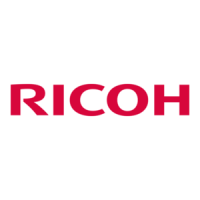In the dark, the drum charge roller [C] imparts a negative charge to the OPC drum. (The roller is kept
clean by cleaning roller [D].)
3. Laser Exposure
The laser unit, controlled by the BICU, fires a beam [E] at the drum, drawing the latent electrostatic
image on the drum surface. (Exposure by laser dissipates the local negative charge.)
4. ID (Image Density) Sensor
The ID sensor [F] periodically measures (a) drum surface reflectivity, and (b) reflectivity of a test pattern
image drawn on the drum. The BICU uses ID sensor data to adjust charge-roller voltage, and uses
both ID sensor data and TD sensor [J] data to adjust the toner density.
5. Development
Augers at [G] carry developer (carrier/toner mix) to the magnetic development roller [H]. The roller
creates a developer "brush" that rubs against the drum, causing toner to adhere to the electrostatic
image. (The doctor blade [I] restricts the height of the "brush." The TD (toner density) sensor [J] measures
the ratio of toner in the developer.)
6. Image Transfer
Paper moves between the drum and the transfer roller [K]. A positive charge applied to the transfer
roller pulls toner off the drum and onto the paper, while also attracting the paper itself.
7. Paper Separation
Paper is separated from the drum as a result of (a) electrostatic attraction of paper toward transfer
roller, and (b) a high AC voltage applied to the discharge plate [L].
8. Cleaning
The cleaning blade [M] scrapes remaining toner from the drum, and the toner collection coil [N]
retrieves this toner.
9. Quenching
Light from the quenching lamp [O] neutralizes the charge on the drum surface.
Copy Process
249

